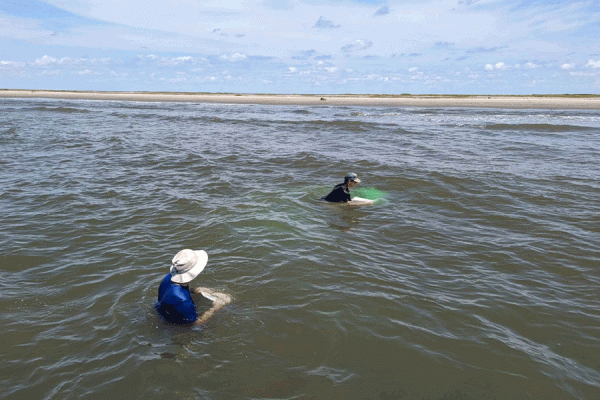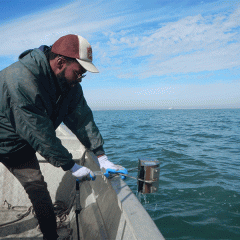While finding the proverbial needle in a haystack might be difficult, University of New Orleans (UNO) earth and environmental sciences professor Mark Kulp and his research team have enlisted technology to help them with an equally daunting task—tracking grains of sand.

The sand that the team is tracking is used in coastal restoration projects to help combat land loss and provides a buffer to reduce the force of storm surge that can lead to flooding and other harmful environmental impacts. The team’s research in tracking the movement of such sand could help determine the best location for placing sediment in future restoration plans.
“The whole idea is to be more effective and efficient in the money and the effort we are spending on these beach ‘renourishment’ projects,” Kulp said.
Kulp is the UNO principal investigator for a $108,728 grant from The Water Institute of the Gulf, funded through the Louisiana Coastal Protection and Restoration Authority on a year-long project to trace and analyze sediment movement on the westernmost barriers of Lafourche Parish.
The goal of that $70 million restoration project, according to state officials, is to create and nourish more than 300 acres of marsh, dune and beach along a 7-mile shoreline to reduce the impacts of storm events. The project added 9.2 million cubic yards of sediment to protect endangered and protected migratory species and critical infrastructures, including Port Fourchon and Highway 1, a vital hurricane evacuation route for Fourchon and Grand Isle.
The Louisiana Coastal Protection and Restoration Authority (CPRA) is responsible for operating projects that restore, create, enhance and maintain coastal wetlands in the state. As part of that oversight, CPRA periodically evaluates sediment dynamics to determine project success and ecosystem sustainability.

UNO researchers, led by Kulp, will analyze the sediment transport trends along the western Caminada Headland between West Belle Pass and Raccoon Pass in Lafourche Parish using ‘ecotrace’ pellets—fluorescent grains of sand.
Sand can go in a number of different directions, Kulp said. It can be transported offshore, it might be transported along the beach in the wave or surf zone, or it can be transported high upon the beach during a major storm and become stranded in the dunes or elsewhere.
To figure out how an individual sand grain is transported, researchers employ a technique called particle tracing using fluorescent replicates. The fabricated pellets are replicas of real grains of sand, except they are fluorescent. “You want that particle to be just like the regular sand in terms of density and size and other characteristics,” Kulp said.
Samples of sand were taken from several locations in the area prior to the spreading of hundreds of kilograms of the fluorescent ecotrace pellets. “We’ve done two sediment sampling efforts already. Once hurricane season is over, we will do another one at the end of the year,” Kulp said.
“Basically, we’ll have four different sample sets over the course of a year and a half to indicate how these particles moved around this particular part of the coast.” The samples will be sent to a company that specializes in analyzing sand grains. Researchers expect to create a final report by next spring.
“Once we know where those fluorescent particles are moving to along the shoreline, then we can make some interpretations about how the sediment is being transported,” Kulp said. “What that means for restoration projects is that maybe we learn we shouldn’t have put so much sand at this location because the sand gets transported way offshore. Or, if we put it here, it stays in the system and actually helps rebuild the beach more effectively.” Information courtesy of New Orleans Magazine.
 TEXTILES.ORG
TEXTILES.ORG


